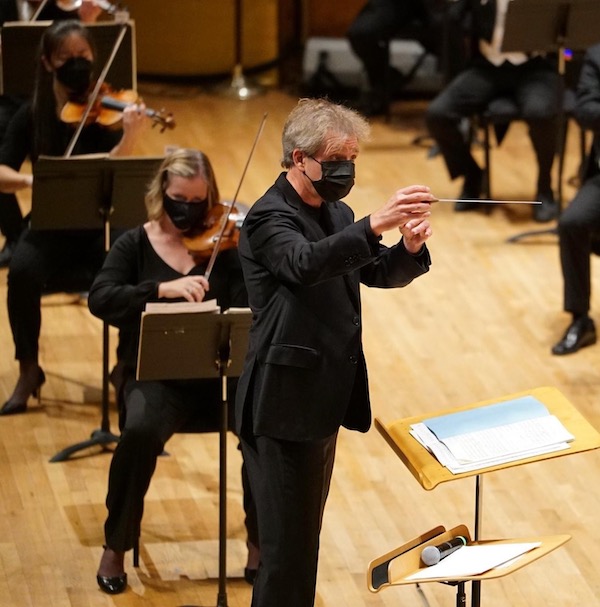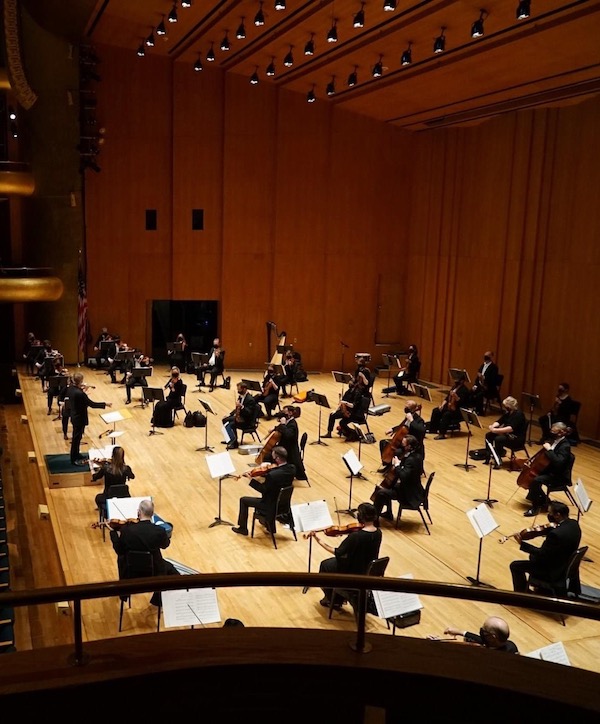Utah Symphony’s cautious opening proves a moving experience

The Utah Symphony opened its 2020-21 season on time Thursday night, ending a six-month intermission. Earlier the same day the Utah Department of Health reported a state record of 911 new cases of the novel coronavirus.
The orchestra took abundant care in its first concert since the Covid-19 pandemic stopped the music world in its tracks. The Abravanel Hall stage was extended to allow at least 6 feet of distance between the night’s performers—about 40 string players, joined briefly by harpist Louise Vickerman and even more briefly by principal percussionist Keith Carrick.
There was a similar buffer between audience members and groups. Patrons were admitted to the hall on the honor system after prior confirmation that they were healthy and without Covid symptoms and reaffirming their commitment to wear face masks for the duration. For good measure, violinists and violists brought their instrument cases onstage with them to minimize backstage interaction. Similarly, the short, hour-long program dispensed with intermission and avoided unwonted milling of audience members.
The necessary precautions seemed like a small price to the 160 listeners in Thursday’s audience. (The orchestra expects up to 400 for each of the next two evenings.) Prolonged applause greeted music director Thierry Fischer, who saluted concertmaster Madeline Adkins with a fist bump as he took the stage. The traditional opening-night rendition of The Star-Spangled Banner carried more pathos than at any time since the immediate aftermath of 9/11.
Fela Sowande’s “Joyful Day” opened the show in festive fashion. In this first movement from the Nigerian composer’s 1944 African Suite based on West African tunes, it may have taken a few bars for the string sound to coalesce, but the orchestra soon showed itself in top form.
Barber’s Adagio for Strings followed, in case anyone needed a reminder that we’re living through a somber time. The performance was sensitively shaped, with a climax of shattering poignancy.

The string orchestra got to show even more range in the short evening’s major work, Tchaikovsky’s Serenade for Strings. The cellists gave the first movement enough heft to make listeners forget they were hearing only half an orchestra. The ensuing second waltz brought a welcome light touch. The remainder of the piece felt like the embodiment of cautious optimism, blossoming gloriously from the gentlest of beginnings.
“You simply cannot imagine how happy we are to be here tonight,” the masked but clearly emotional Fischer said in announcing the three unbilled selections that followed: Puccini’s lilting I crisantemi, Sowande’s danceable “Akinla” (also from the African Suite) and a string arrangement of Copland’s “Hoedown” from Rodeo.
Fischer closed the evening with a novel way of bringing the rest of the Utah Symphony into the proceedings. Early in the pandemic, the orchestra commissioned the 4-minute Fanfare of Hope and Solidarity from Augusta Read Thomas, then recorded their parts at home. The finished performance, expertly edited by Andrea Peterson and projected above the Abravanel Hall stage, was a touching and bittersweet closer.
The Utah Symphony will repeat the program 7:30 p.m. Friday and Saturday. Seating is limited and strict health protocols must be observed.
Next week’s concerts will feature Bach’s Brandenburg Concerto No. 3 and Schoenberg’s Verklärte Nacht. Masterworks programming for the rest of 2020 will be announced as the public-health situation unfolds. utahsymphony.org; 801-533-6683.